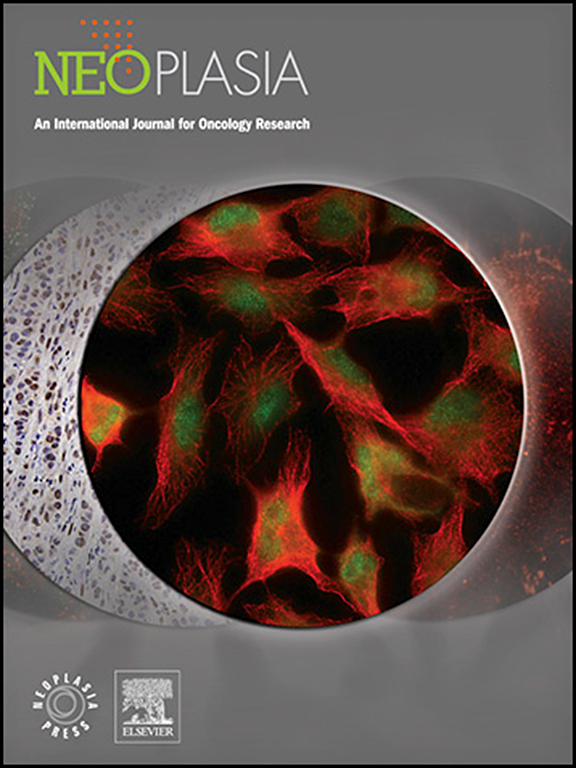豪猪表达促进口腔癌的进展
IF 4.8
2区 医学
Q1 Biochemistry, Genetics and Molecular Biology
引用次数: 0
摘要
口腔鳞状细胞癌(OSCC)是最常见的口腔癌类型,其之前通常有潜在的恶性疾病,组织学上诊断为不典型增生。在这种情况下,我们和其他人已经为Wnt/β-catenin通路的促致癌作用提供了证据,其中Wnt配体稳定并允许β-catenin重新定位到细胞核中以转录促生存和促增殖基因。然而,Porcupine (PORCN),一种催化Wnt配体棕榈酰化的o -酰基转移酶,在OSCC癌变中的作用尚不清楚。此外,一种新的PORCN抑制剂LGK974的有效性仍有待阐明。通过使用不同的离体、体内和体外OSCC癌变模型,我们发现PORCN表达在高级别非典型增生以及中/低分化OSCC中显著增加。与这些观察结果一致,参与Wnt/β-catenin通路的关键蛋白的表达也升高。重要的是,LGK974(一种化学PORCN抑制剂)治疗减少了4-硝基喹啉1-氧化物(4NQO)治疗小鼠口腔病变的数量和大小。这些结果强调了PORCN在OSCC癌变过程中的作用。本文章由计算机程序翻译,如有差异,请以英文原文为准。
Porcupine expression promotes the progression of oral carcinogenesis
Oral squamous cell carcinoma (OSCC) is the most common type of oral cancer, which is usually preceded by a potentially malignant disorder histologically diagnosed as dysplasia. We and others have provided evidence for the pro-carcinogenic role of the Wnt/β-catenin pathway in this context, in which Wnt ligands stabilize and allow relocalization of β-catenin to the nucleus for transcription of pro-survival and pro-proliferation genes. However, the contribution of Porcupine (PORCN), an O-acyltransferase that catalyzes the palmitoylation of Wnt ligands, to OSCC carcinogenesis is not known. Moreover, the effectiveness of LGK974, a novel PORCN inhibitor remains to be elucidated. By using different ex vivo, in vivo and in vitro OSCC carcinogenesis models, we show that PORCN expression is significantly increased in high-grade dysplasia as well as moderately/poorly- differentiated OSCC. Consistent with these observations, expression of key proteins involved in the Wnt/β-catenin pathway are elevated as well. Importantly, the treatment with LGK974, a chemical PORCN inhibitor, reduced the number and size of oral lesions in mice treated with 4-Nitroquinoline 1-oxide (4NQO), a tobacco smoke surrogate. These results highlight the role of PORCN during OSCC carcinogenesis.
求助全文
通过发布文献求助,成功后即可免费获取论文全文。
去求助
来源期刊

Neoplasia
医学-肿瘤学
CiteScore
9.20
自引率
2.10%
发文量
82
审稿时长
26 days
期刊介绍:
Neoplasia publishes the results of novel investigations in all areas of oncology research. The title Neoplasia was chosen to convey the journal’s breadth, which encompasses the traditional disciplines of cancer research as well as emerging fields and interdisciplinary investigations. Neoplasia is interested in studies describing new molecular and genetic findings relating to the neoplastic phenotype and in laboratory and clinical studies demonstrating creative applications of advances in the basic sciences to risk assessment, prognostic indications, detection, diagnosis, and treatment. In addition to regular Research Reports, Neoplasia also publishes Reviews and Meeting Reports. Neoplasia is committed to ensuring a thorough, fair, and rapid review and publication schedule to further its mission of serving both the scientific and clinical communities by disseminating important data and ideas in cancer research.
 求助内容:
求助内容: 应助结果提醒方式:
应助结果提醒方式:


